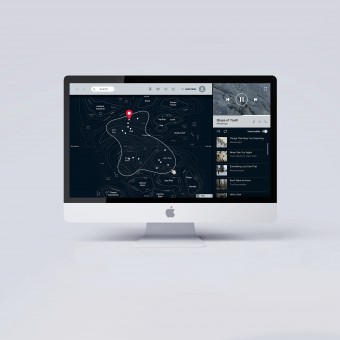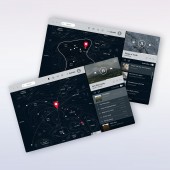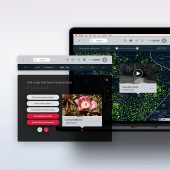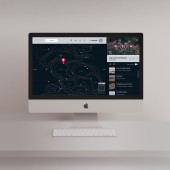
| THE AWARD |
| CATEGORIES |
| REGISTRATION |
| SUBMIT YOUR WORK |
| ENTRY INSTRUCTIONS |
| TERMS & CONDITIONS |
| PUBLICATIONS |
| DATES & FEES |
| METHODOLOGY |
| CONTACT |
| WINNERS |
| PRESS ROOM |
| GET INVOLVED |
| DESIGN PRIZE |
| DESIGN STORE |
| THE AWARD | JURY | CATEGORIES | REGISTRATION | PRESS | WINNERS | PUBLICATIONS | ENTRY INSTRUCTIONS |
Musiac Music Recommendation Service by Chia-Min Lin |
Home > Winners > Design #91014 >Interview |
 |
|
FS: What is the main principle, idea and inspiration behind your design?
CL: The main idea is to map out all genres on the 2 dimension graphic and visualize user's taste in the shape of a bubble. User could drag the outline of the bubble to generate different recommendations. I referred to the philosophical definitions of a map and how it help us to find directions.
FS: What has been your main focus in designing this work? Especially what did you want to achieve?
CL: I've always been interested in how our brain process information. Human's cognition is a result of both internal and external. If interface represents a tangent point of our mind the real world, it shouldn't be considered as merely astheatic issue. So the goal behind this project aims to exploring what roles interface could play in the decision making process.
FS: What are your future plans for this award winning design?
CL: I am looking for opportunities to present this project. I've shown this project to data analysist and they've shown high interest. So maybe I will write a paper to describe the goal and intentions behind.
FS: How long did it take you to design this particular concept?
CL: I spent probably 6 months to define what's the problem of searching and recommendation system before I landed on this mapping idea.
FS: Why did you design this particular concept? Was this design commissioned or did you decide to pursuit an inspiration?
CL: I've always struggled to tell Youtube or Google that "this is not what I'm looking for" because current systems don't provide feedback mechanism to their audiences. It's a really common frustration among its users, so, as an interaction designer, I tried to propose a different perspective of how to solve this.
FS: Is your design being produced or used by another company, or do you plan to sell or lease the production rights or do you intent to produce your work yourself?
CL: I haven't think about it because this project is just a beginning. But I am happy to work with anyone who is interested in Musiac to make it into reality.
FS: What made you design this particular type of work?
CL: Lots of times when I'm listening to music, I feel I'm in a loop and couldn't find the way to expand my recommendations. I don't know how to break the loop for a long time until I started to see interface & experience design differently, then I see possibilities to propose the unconventional solutions.
FS: Where there any other designs and/or designers that helped the influence the design of your work?
CL: Yes, I consulted this project with many people, my professor, my colleagues, the founder of EveryNoise, sociologist, and programmers. Lots of people have helped me along the design process.
FS: Who is the target customer for his design?
CL: Any person who struggled to expand their musical taste on current platforms. People who are tech-savvy, willing to spend time to do research to make sure they're not trapped in the comfort zone.
FS: What sets this design apart from other similar or resembling concepts?
CL: Musica has a very unusual interface, its UX was actually build on its UI. Musiac's interface determined how people see options. It's usually the opposite in current industry — build the framework of UX then UI polish the work. Musiac gives a further goal of data visualization to inspire users to proactively do something.
FS: How did you come up with the name for this design? What does it mean?
CL: Musiac means " the maniac in music". Also has a slightly implication of the art of mosaic.
FS: Which design tools did you use when you were working on this project?
CL: Paper/pencil. Adobe. Imaginations.
FS: What is the most unique aspect of your design?
CL: It nothing like current musical interface because it has a higher level goal of helping people process information better to fight against algorithm autocracy.
FS: Who did you collaborate with for this design? Did you work with people with technical / specialized skills?
CL: I consulted with many people along the way, but I build this project by myself so it really takes me a long time to finish it.
FS: What is the role of technology in this particular design?
CL: Algorithm is the key to map out all genres. There are over 40 millions songs exist on a single platforms, without the help of programing, it's impossible to visualize the fuzzy relations between each songs.
FS: Is your design influenced by data or analytical research in any way? What kind of research did you conduct for making this design?
CL: I did multiple contextualized research, such as interviews, remote user testing and behavior observation. The analytical research includes study reports on consumer behavior change, do questionnaire to seek people's feeling about songs, etc.
FS: What are some of the challenges you faced during the design/realization of your concept?
CL: The business and advertising dominates the final results of recommendation. So the end users needs are actually contradicting with the need of industry. It might not have an immediate impact on my project since it's not on the market, but it hard to seek the right solution when there're other intention behind the algorithm.
FS: How did you decide to submit your design to an international design competition?
CL: My colleague told me I should try to publish my project so I start to see what are the competitions I could join.
FS: What did you learn or how did you improve yourself during the designing of this work?
CL: I learned lots of history about algorithms and how it evolved to this complex level. The different goals of rating system and how it gradually become recommendation index. Also I learned lots of After Effects skills.
FS: Any other things you would like to cover that have not been covered in these questions?
CL: No.
FS: Thank you for providing us with this opportunity to interview you.
A' Design Award and Competitions grants rights to press members and bloggers to use parts of this interview. This interview is provided as it is; DesignPRWire and A' Design Award and Competitions cannot be held responsible for the answers given by participating designers.
| SOCIAL |
| + Add to Likes / Favorites | Send to My Email | Comment | View Press-Release | Translations |





